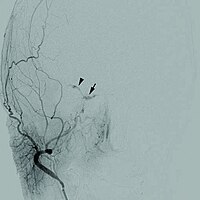
Photo from wikipedia
Purpose Immediate hemodynamic compromise of a side branch jailed by a flow diverter is an infrequently encountered phenomenon in bifurcation aneurysms which is attributed by some authors to the “Coanda… Click to show full abstract
Purpose Immediate hemodynamic compromise of a side branch jailed by a flow diverter is an infrequently encountered phenomenon in bifurcation aneurysms which is attributed by some authors to the “Coanda effect”. We aimed to check the relevance of this phenomenon with aneurysm occlusion rate on follow-up in bifurcation aneurysms treated by flow diversion. Methods All intracranial aneurysms treated with flow diverters in a single center were retrospectively reviewed. 30 patients treated by flow diverters which jail a major intracranial side branch originating from the aneurysm were identified. 7 patients among these demonstrated hemodynamic compromise of the jailed side branch intraprocedurally, immdeately after FD deployment (Group 1). 23 patients did not demonstrate any immediate side branch stagnation or occlusion (group 2). Patients in group 1 were treated by induced hypertension and augmentation of antiplatelet therapy in the perioperative period. Mann-Whitney U test was used to compare the diameters of the side branch, the parent artery and flow diverter as well as the angle between the parent artery/side branch between these 2 groups. Chi-square analysis was performed to compare the rate of occlusion of aneurysms at 6 months and at final follow-up. Results None of the patients in group 1 developed any permanent neurologic deficits. There were no significant differences between parent artery diameters, side branch diameters, flow diverter diameters and side branch angles between the two groups. Occlusion rate was similar in both groups at 6 months. However at the final follow-up there was a significantly higher rate of aneurysm occlusion in group 1 versus group 2 (p=0.03). Conclusion Intraprocedural, pressure-related compromise of a jailed side branch originating from an intracranial aneurysm treated by flow diversion does not necessarily indicate a bad outcome, on the contrary it may predict occlusion of the aneurysm on long term follow-up. Disclosures: Y. Senturk: None. F. Cay: None. A. Peker: None. O. Ocal: None. A. Arat: None.
Journal Title: Journal of NeuroInterventional Surgery
Year Published: 2017
Link to full text (if available)
Share on Social Media: Sign Up to like & get
recommendations!